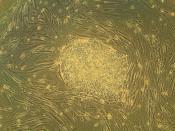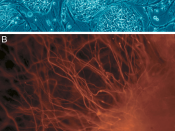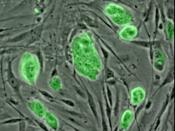Stem cells found in the multicellular organism and can be develop in many different cell types. Stem cell can serve in many tissues as an internal repair system and divide without limit to replenish other cells as long as animals or person is alive. When stem cell divides, new cell have the potential to remain a stem cell or another cell. Stem cells have two main characteristics that make them distinguished from other cell types. First, they renew themselves through cell division, which are unspecialized cells capable. Second, they can be certain physiologic or experimental, which become tissue or organ with a specific function.
Stem cells are different from others cells in the body, which contain three general properties. First, they Capable of dividing and renewing themselves for long periods. Cells such as muscle, blood, and nerve do not normally replicate themselves they replicate many times through proliferate. The starting population of stem cells that proliferate for many months in the laboratory can yield millions of cells.
In the laboratory if the results cells continue to unspecialized, like the parent stem cells, the cells are capable of long-term self-renewal. Second, stem cells are unspecialized. Stem cell does not have any tissue structures that allow it to perform specialized functions. Nevertheless, unspecialized stem cell can give rise to specialized cells, such as heart muscle cells, blood cells, and nerve cells. Third, rise to specialized cells. The stem cells to remain unspecialized and give rise to specialized cells, the process called differentiation. Scientists are just beginning to follow on how signals trigger the stem cell differentiation. A cell's genes control internal signals interspersed across long DNA strands, other cells secrete chemicals causing external signals, through physical contact with neighboring cells and microenvironment molecules. Adult stem cells typically require the cell types of...


